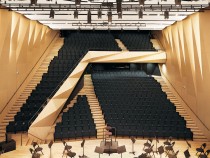
© Roland Halbe
The heart of this conservatory of music, dance and theatre in Aix-en-Provence is formed by the auditorium, which provides seating for 500 people. Rhythmically folded surfaces are a distinguishing feature not only of this space but of the outer facade, too, where they create an animated play of light and shade.
With its L-shaped plan, the building occupies a site in the south-west of the historical city centre between a newly built promenade and a motorway sliproad two storeys lower. On the quieter courtyard face, the conservatory flanks the Cité du livre cultural centre. Here, in contrast to the vertical folds of the walls on the outer sides, the facades are articulated in horizontal strips. At the corners of the building, where the external walls are set at oblique angles, the facade is fully glazed, highlighting the entrances on different levels.
From the courtyard, access to the building is via a glazed strip along the large lower foyer. From here, visitors proceed up a straight-flight staircase to a surprisingly small corresponding space on the upper level, where the main entrance is situated facing the promenade. Various geometries and materials converge at this point, creating a complex, shimmering sequence of spaces. From here, one has access to the auditorium and, via a central corridor, to the music studios in the narrower wing of the building.
The auditorium is clad entirely in oak panelling. The side walls are smooth at the base, but articulated towards the top into triangu-lated, prismatic areas. In conjunction with the white ceiling panels, which slope in different directions, a series of faceted surfaces is thus created which ensure the distribution of sound necessary for good acoustics. Any correspondence between the folded surfaces of the facade and those in the hall remains a purely formal analogy, however.
With its L-shaped plan, the building occupies a site in the south-west of the historical city centre between a newly built promenade and a motorway sliproad two storeys lower. On the quieter courtyard face, the conservatory flanks the Cité du livre cultural centre. Here, in contrast to the vertical folds of the walls on the outer sides, the facades are articulated in horizontal strips. At the corners of the building, where the external walls are set at oblique angles, the facade is fully glazed, highlighting the entrances on different levels.
From the courtyard, access to the building is via a glazed strip along the large lower foyer. From here, visitors proceed up a straight-flight staircase to a surprisingly small corresponding space on the upper level, where the main entrance is situated facing the promenade. Various geometries and materials converge at this point, creating a complex, shimmering sequence of spaces. From here, one has access to the auditorium and, via a central corridor, to the music studios in the narrower wing of the building.
The auditorium is clad entirely in oak panelling. The side walls are smooth at the base, but articulated towards the top into triangu-lated, prismatic areas. In conjunction with the white ceiling panels, which slope in different directions, a series of faceted surfaces is thus created which ensure the distribution of sound necessary for good acoustics. Any correspondence between the folded surfaces of the facade and those in the hall remains a purely formal analogy, however.





